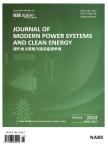Operation-area-constrained Adaptive Primary Frequency Support Strategy for Electric Vehicle Clusters
作者机构:College of Electrical EngineeringSichuan UniversityChengdu 610065China Electric Power Research InstituteState Grid Shanxi Electric Power CompanyTaiyuan 030001China
出 版 物:《Journal of Modern Power Systems and Clean Energy》 (现代电力系统与清洁能源学报(英文))
年 卷 期:2023年第11卷第6期
页 面:1982-1994页
核心收录:
学科分类:0808[工学-电气工程] 080802[工学-电力系统及其自动化] 08[工学] 082302[工学-交通信息工程及控制] 0823[工学-交通运输工程]
主 题:Primary frequency control frequency support electric vehicle vehicle-to-grid(V2G) operation area charging behavior
摘 要:Due to their fast response and strong short-term power throughput capacity, electric vehicles(EVs) are promising for providing primary frequency support to power grids. However, due to the complicated charging demands of drivers, it is challenging to efficiently utilize the regulation capacity of EV clusters for providing stable primary frequency support to the power grid. Accordingly, this paper proposes an adaptive primary frequency support strategy for EV clusters constrained by the charging-behavior-defined operation area. First, the forced charging boundary of the EV is determined according to the driver s charging behavior, and based on this, the operation area is defined. This ensures full utilization of the available frequency support capacity of the EV. An adaptive primary frequency support strategy of EV clusters is then proposed. The output power of EV is adaptively regulated according to the real-time distance from the EV operating point to the forced charging boundary. With the proposed strategy, when the EV approaches the forced charging boundary, its output power is gradually reduced to zero. Then, the rapid state-of-charge declines of EVs and sudden output power reductions in EV clusters caused by forced charging to meet the driver s charging demands can be effectively avoided. EV clusters can then provide sustainable frequency support to the power grid without violating the driver s charging demands. Simulation results validate the proposed operation-area-constrained adaptive primary frequency support strategy, which outperforms the average strategy in terms of stable output maintenance and the optimal utilization of regulation capacities of EV clusters.



